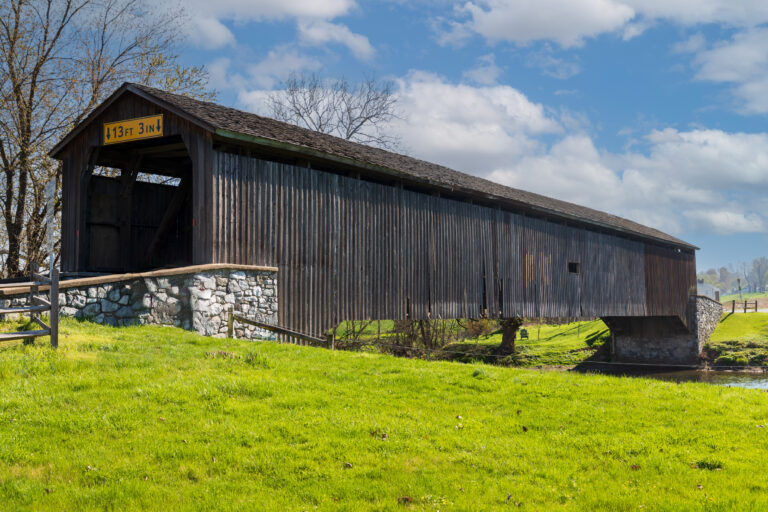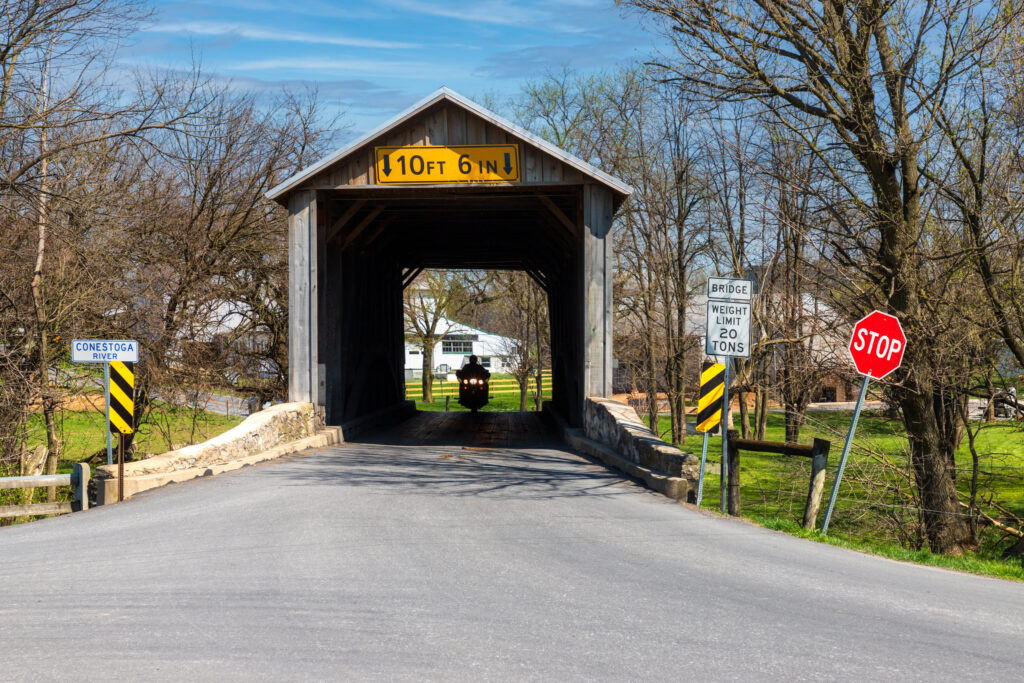Nestled in the heart of Pennsylvania’s scenic countryside, Lancaster County is best known for being Amish Country. And what could be better than a scenic tour through the stunning landscape of the Pennsylvania Dutch countryside? There is a rich history dating back to the 18th century and my favorite part of that history may be the covered bridges! The detail and craftsmanship of these historic gems are a treat to experience.
When I found out we would be in the area for a week I was as excited as a kid in a candy store! (Truthfully, I’m pretty excited in an actual candy store too!) The very mention of covered bridges invokes a sense of nostalgia, harking back to a bygone era. These wooden structures stand as witnesses to history, bearing stories of travel and connection. Minimalistic Amish aesthetics further amplify the charm, weaving in intricate details that tell tales of craftsmanship and dedication.
There are over 25 covered bridges in the county, but with only an afternoon to explore, I narrowed it down to 8 near our campground and mapped a route for a motorcycle ride through the picturesque countryside. With beautifully preserved architecture, horse-drawn buggies, and lush farmlands stretching as far as the eye can see, it was the best scenic route in Lancaster County! I mean, what could be better than a motorcycle ride through the stunning landscape of the Pennsylvania Dutch countryside? Not much! The week we spent in PA went by too fast because the exploring was some of the best of the year!
Hunnsecker's Mill Covered Bridge
The first stop was Hunnsecker’s Mill Covered Bridge, a historic and charming landmark spanning the tranquil waters of the Conestoga River. The bridge was built in 1843, providing both a functional crossing and an iconic symbol of the region’s rich history. With a length of approximately 180 feet, the bridge boasts a classic design characterized by its wooden trusses and iconic pitched roof. Its red exterior has long since faded to a weathered brown giving it a nice historic feel.
An interesting fact about Hunnsecker’s Mill Covered Bridge is that it has been swept away by flood waters numerous times, most recently in 1972 following Hurricane Agnes!


Weaver's Mill Covered Bridge
Weaver’s Mill Covered Bridge is a cherished historical gem that transports visitors back to a simpler time. Erected in 1878, this charming, covered bridge showcases the intricate craftsmanship of the era, reflecting the enduring legacy of American engineering. The bridge spans approximately 85 feet and captivates with its traditional wooden trusses, iconic red exterior, and steep gabled roof.
Also known as Isaac Shearer’s Mill Bridge, Weaver’s Mill Covered Bridge serves as a beloved landmark and a testament to the region’s rural heritage. Its inviting ambiance and nostalgic aura make it a favored spot for photography, leisurely strolls, and a glimpse into the past of a thriving agricultural community. It was added to the National Register of Historic Places in 1980.
Poole Forge Covered Bridge
Poole Forge Covered Bridge, a masterpiece of architectural heritage, opened in 1859. It is 99 feet long and spans the Conestoga River. Standing as a testament to the bygone era’s craftsmanship, this historic covered bridge captures the essence of time, with its weathered timbers and sturdy trusses narrating tales of a different age. I loved the blend of old and new, with the bridge tucked into the rolling countryside, providing a path for farmers and tourists alike.
The bright red color stands out in the countryside and is a reminder of the more frugal times when the color was created by combining dirt and rust with paint. The mixture created a paint-like coating that protected the wood.


Bitzer’s Mill Covered Bridge
Bitzer’s Mill Covered Bridge was built in 1846 and is the oldest covered bridge still in use in Lancaster County. It stands as a captivating example of a historic covered bridge frozen in time. Tucked into the tranquil landscapes, this architectural gem captures the essence of a bygone era, where wooden trusses and weathered planks intertwine to create a symphony of nostalgia.
The resonance of history is palpable as you journey beneath its protective roof. The symphony of creaking wood and distant echoes transports you to an era where horse-drawn carriages echoed through the valley.
Eschelman’s Mill Covered Bridge
Eschelman’s Mill Covered Bridge, also known as Leaman’s Place Covered Bridge, is 113 feet long. It spans Pequea Creek. It was built in 1845 and then rebuilt in 1893 but I couldn’t find any information about why it was rebuilt. The land it was built on was settled by the family of Mary Ferree in 1712 in an area occupied by the Pequea Indians.
Can you imagine what life might have been like over 300 years ago? Eschelman’s Mill Covered Bridge isn’t just a structure; it’s a passage into Lancaster’s heritage. The gentle rustling of leaves and the distant gurgle of water beneath remind you that you stand on the threshold of time. It stands as a silent storyteller, inviting you to unravel its tales and bask in its enduring beauty – a bridge that spans both distance and history, connecting us to a world that remains eternally captivating.


Lime Valley Covered Bridge
Lime Valley Covered Bridge, built in 1871, is a timeless marvel nestled in the heart of history-rich Lancaster County and stands as a graceful embodiment of a historic covered bridge. Constructed with meticulous craftsmanship, this bridge transports you to an era where simplicity and elegance merged seamlessly. It is 103 feet long and spans Pequea Creek.
Lime Valley is a haven of visual inspiration. Its rustic façade exudes a charm that’s a delight to photograph. The interplay of light and shadows dancing on its wooden trusses creates a symphony of textures, making it a canvas for artistic expression.
Baumgardener's Covered Bridge
Baumgardener’s Covered Bridge offers a window into the past and the charm of historic covered bridges. Built in 1860, this bridge stands as a symbol of architectural legacy. It is 120 feet long and spans the Pequea Creek.
The character of this bridge is classic with the red hues reflecting the essence of simpler times. Walking through its sheltered corridor connects you to history, conjuring images of horse-drawn carriages and a glimpse into the grace of preservation, reminding us of the significance of safeguarding history’s treasures.

Amish Countryside
Unfortunately, the last bridge on the list was closed and seemed to be on private property so we did not get to explore it but seeing 7 amazing covered bridges and touring the bright green landscapes of the Pennsylvania Dutch countryside made for a perfect day!
When it comes to capturing the perfect shot of a bridge, here are a few tips for fellow photography enthusiasts. First, find a vantage point that highlights the bridge’s unique architecture against its surroundings. Experiment with different angles to showcase the character of the bridge. Don’t forget to incorporate natural elements like water or foliage to add depth and context to your frame. Happy shooting, fellow bridge admirer!
The magic of Amish Country’s covered bridges lingers long after the journey ends. The fusion of Amish culture and bridge heritage creates an indelible impression that transcends time. Revisiting these bridges, memories resurface, standing the test of time, reminding us of the beauty and heritage that connect Lancaster County’s past to its present and future.
Have you visited Lancaster County, PA? I’d love to hear your favorite things about it and if you haven’t visited yet, what do you most want to see?
Please check out the website for more images from Lancaster County, PA, and sign up for the newsletter to get all the latest content!





